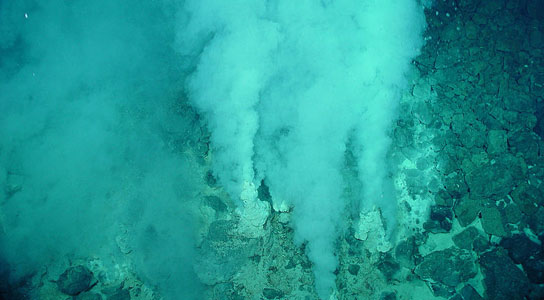
Scientists have found evidence that life persists even when hydrothermal sea vents become dormant. Credit: NOAA
Based on the samples provided by U.S. Navy deep sea submersible Alvin, USC microbiologists discovered that life continues at hydrothermal vents even after they go dormant. Once the vents go cold, microbes that once feed on the hot fluid methane and sulfur are replaced by microbes that feed on the solid iron and sulfur that make up the vents themselves. This evidence provides researchers with a rare example of ecological succession in microbes.
Scientists at the University of Southern California (USC) have uncovered evidence that even when hydrothermal sea vents go dormant and their blistering warmth turns to frigid cold, life goes on.
Or rather, it is replaced.
A team led by USC microbiologist Katrina Edwards found that the microbes that thrive on hot fluid methane and sulfur spewed by active hydrothermal vents are supplanted, once the vents go cold, by microbes that feed on the solid iron and sulfur that make up the vents themselves.
The findings — based on samples collected for Edwards by the U.S. Navy deep-sea submersible Alvin (famed for its exploration of the Titanic in 1986) — provide a rare example of ecological succession in microbes.
The findings were published in a mBio article authored by Edwards, USC graduate researcher Jason Sylvan, and Brandy Toner of the University of Minnesota.
Ecological succession is the biological phenomenon whereby one form of life takes the place of another as conditions in an area change — a phenomenon documented in plants and animals.
For example, after a forest fire, different species of trees replace the older ones that stood for decades.
Scientists have long known that active vents provide the heat and nutrients necessary to maintain microbes. But dormant vents — lacking a flow of hot, nutrient-rich water — were thought to be devoid of life.
Hydrothermal vents are formed on the ocean floor with the motion of tectonic plates. Where the sea floor becomes thin, the hot magma below the surface creates a fissure that spews geothermally heated water — reaching temperatures of more than 400 degrees Celsius.
After a geologically brief time of actively venting into the ocean, the same seafloor spreading that brought them into being shuffles them away from the hotspot, and the vents grow cold and dormant.
“Hydrothermal vents are really ephemeral in nature,” said Edwards, professor of biological sciences at the USC Dornsife College of Letters, Arts and Sciences.
Microbial communities on sea floor vents have been studied since the vents themselves were discovered in the late 1970s. Until recently, little attention had been paid to them once they stopped venting.
Sylvan said he would like to take samples on vents of various ages to catalog exactly how the succession from one population of microbes to the next occurs.
Edwards, who recently returned from a two-month expedition to collect samples of microbes deep below the ocean floor, said that the next step will be to see if the ecological succession is mirrored in microbes that exist beneath the surface of the rock.
“The next thing is to go subterranean,” she said.









Be the first to comment on "Scientists Discover Dead Hydrothermal Vents Contain Life"